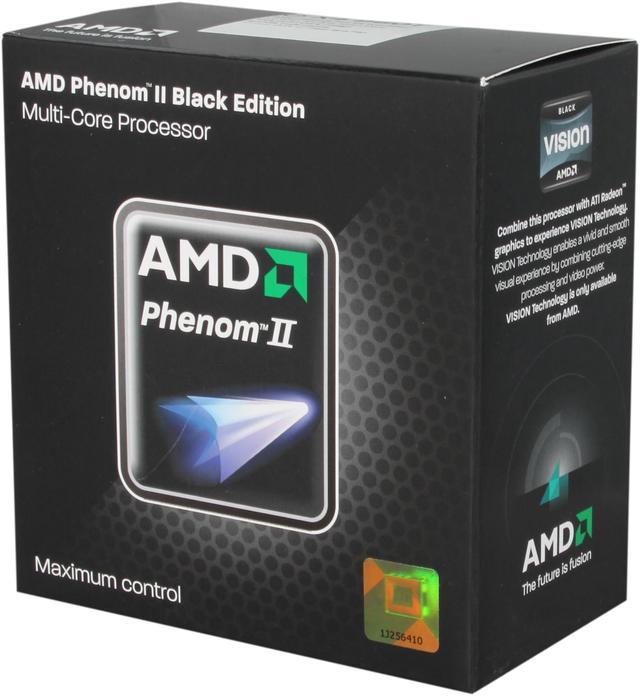Your Browsing History

Make informed decisions with expert advice. Learn More
Any questions? Our AI beta will help you find out quickly.
 AMD64 with Direct Connect ArchitectureAMD64 technology allows the AMD Phenom II X4 960T to run 32-bit applications at full speed while enabling a new generation of powerful 64-bit software applications. Moreover, all AMD Phenom II X4 processors are built on AMD’s revolutionary Direct Connect Architecture, where the processor core is directly connected to the memory, the I/O subsystem, and any other processors in the configuration by high bandwidth Hypertransport links. This cuts down on the latency and improves overall system performance and efficiency.
AMD64 with Direct Connect ArchitectureAMD64 technology allows the AMD Phenom II X4 960T to run 32-bit applications at full speed while enabling a new generation of powerful 64-bit software applications. Moreover, all AMD Phenom II X4 processors are built on AMD’s revolutionary Direct Connect Architecture, where the processor core is directly connected to the memory, the I/O subsystem, and any other processors in the configuration by high bandwidth Hypertransport links. This cuts down on the latency and improves overall system performance and efficiency. True Quad-Core ProcessingWith the power of four processor cores on a single chip, the AMD Phenom II X4 960T processor delivers industry-leading multitasking performance with each core having its own L2 cache memory and ability to quickly share data among cores utilizing the L3 cache.
True Quad-Core ProcessingWith the power of four processor cores on a single chip, the AMD Phenom II X4 960T processor delivers industry-leading multitasking performance with each core having its own L2 cache memory and ability to quickly share data among cores utilizing the L3 cache. Integrated Memory ControllerThe AMD Phenom II X4 960T processor features a high-bandwidth, low-latency integrated memory controller that directly connects the processor to memory for optimum performance, low latency, and high throughput.
Integrated Memory ControllerThe AMD Phenom II X4 960T processor features a high-bandwidth, low-latency integrated memory controller that directly connects the processor to memory for optimum performance, low latency, and high throughput. HyperTransport 3.0 TechnologyHyperTransport Technology (HT or HTT) is a high-speed, low latency, point-to-point link designed to increase communication speeds between integrated circuits in computers, servers, embedded systems, and networking and telecommunications equipment. With HT 3.0 technology the AMD Phenom II X4 960T quad-Core processor enjoys 4000MHz system bus speeds.
HyperTransport 3.0 TechnologyHyperTransport Technology (HT or HTT) is a high-speed, low latency, point-to-point link designed to increase communication speeds between integrated circuits in computers, servers, embedded systems, and networking and telecommunications equipment. With HT 3.0 technology the AMD Phenom II X4 960T quad-Core processor enjoys 4000MHz system bus speeds. AMD Power Management TechnologiesCPU power management technologies including AMD PowerNow! 3.0 (Cool’n’Quiet), CoolCore, and Dual Dynamic Power Management result in proven, measurable benefits for businesses and consumers, including reduced power usage, lower energy costs, and greener PC operation.
AMD Power Management TechnologiesCPU power management technologies including AMD PowerNow! 3.0 (Cool’n’Quiet), CoolCore, and Dual Dynamic Power Management result in proven, measurable benefits for businesses and consumers, including reduced power usage, lower energy costs, and greener PC operation. AMD Virtualization (AMD-V) Technology with Rapid Virtualization IndexingSilicon feature-set enhancements designed to improve the performance, reliability, and security of existing and future virtualization environments by allowing virtualized applications with direct and rapid access to their allocated memory. This helps virtualization software to run more securely and efficiently enabling a better experience when dealing with virtual systems.
AMD Virtualization (AMD-V) Technology with Rapid Virtualization IndexingSilicon feature-set enhancements designed to improve the performance, reliability, and security of existing and future virtualization environments by allowing virtualized applications with direct and rapid access to their allocated memory. This helps virtualization software to run more securely and efficiently enabling a better experience when dealing with virtual systems.